Steamboats in Virginia
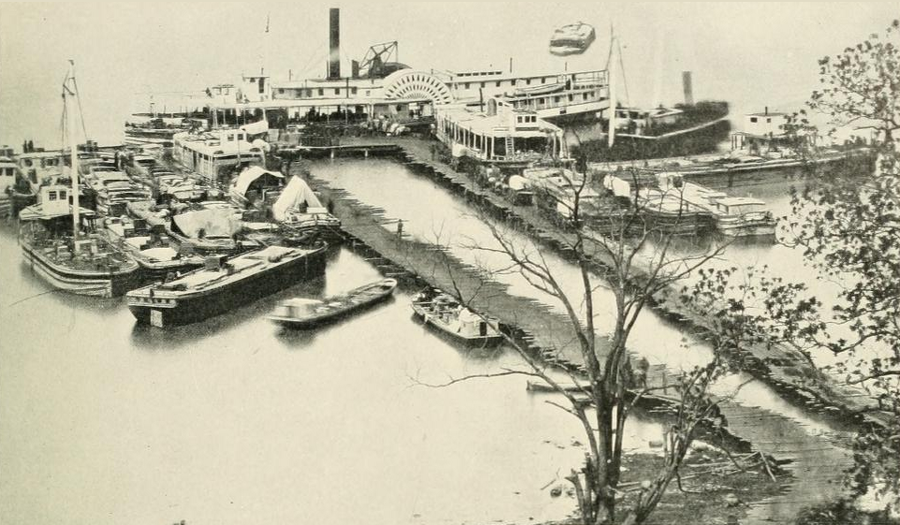
during the Civil War, Union armies were supplied by steamboats that used the Potomac and James rivers to bypass Confederate forces and avoid poor roads, and City Point (pictured above) became a major port
Source: The Photographic History of the Civil War, Military Commerce (p.133)
In 1784, Virginia gave James Rumsey a 10-year license to operate steamboats on the Potomac River, in part because he was endorsed by George Washington. Rumsey successfully tested a steamboat in 1787 at Shepherdstown (now in West Virginia).
That same year, Rumsey's rival John Fitch tested a steamboat on the Delaware River. James Madison supported Fitch's efforts and Virginia issued him a license, but he became embroiled in patent disputes and did not initiate steamboat operations. Robert Fulton later commercialized the technology and is often credited with being the inventor, but a monument near Harpers Ferry commemorates Rumsey's earlier efforts.1
In 1813, regular steamboat service started on the Potomac River. Different boats ran from Washington DC to Marlboro Point/Aquia Creek (near Fredericksburg) and Richmond. Service between Richmond and Baltimore started in 1815, and between Richmond and Norfolk in 1816.
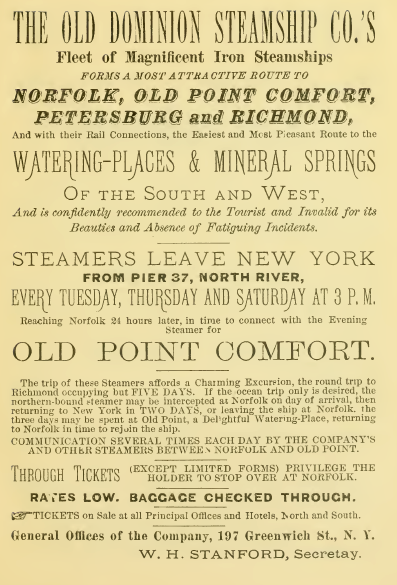
starting in the 1820's, tourists traveled to hotels on Old Point Comfort via steamship
Source: Internet Archive, A history of Old Point Comfort and Fortress Monroe, Va., from 1608 to January 1st, 1881 (1881)
The Old Bay Line started in 1840, and offered overnight service between Baltimore and Norfolk, Point Comfort, and Richmond.
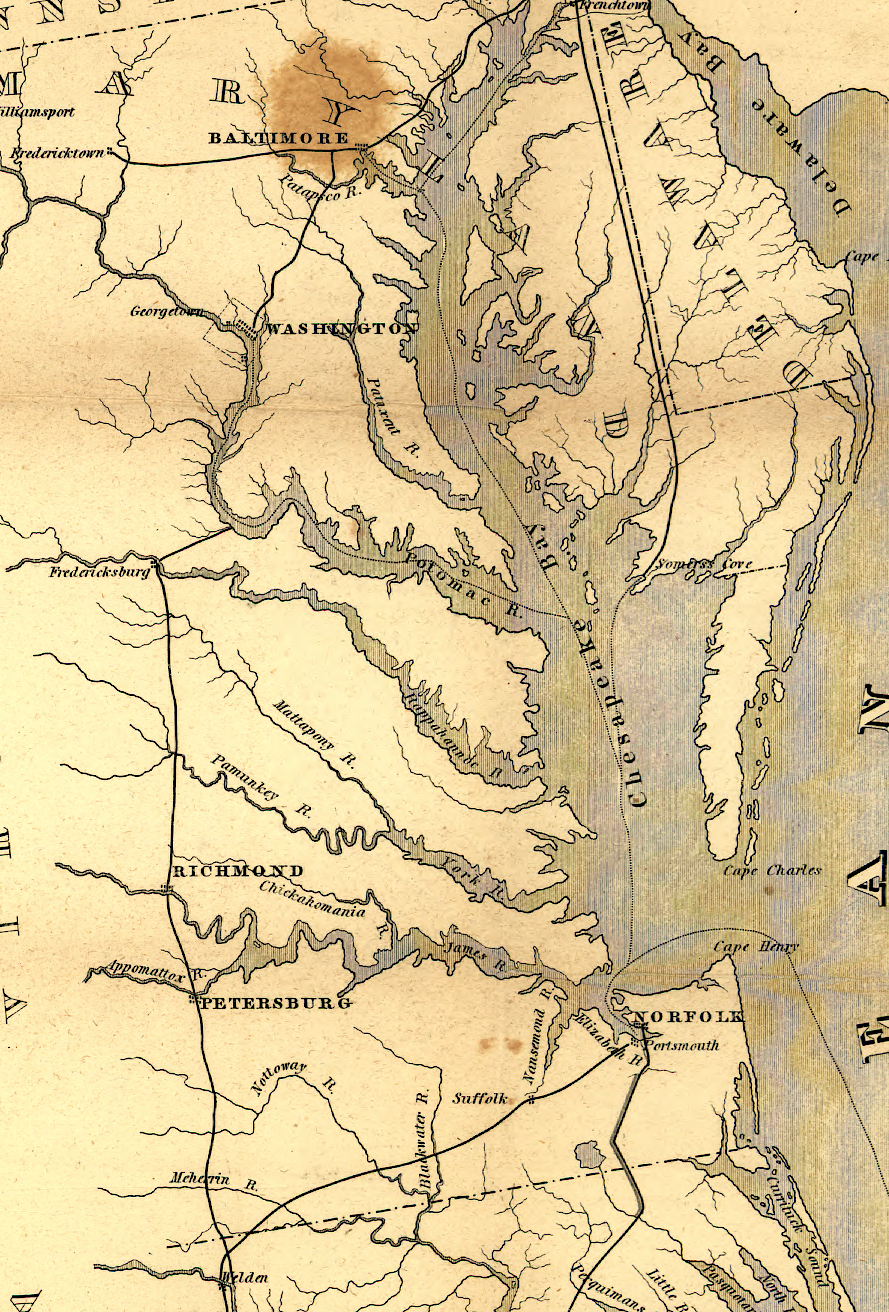
travelers going south from Baltimore used steamboats, both down the Chesapeake Bay and between Washington-Fredericksburg
Source: Library of Congress, Map exhibiting the route of communication between Philadelphia & Charleston (1837)

in 1838, the steamboat from Richmond scheduled stops at six places before reaching Norfolk
Source: Hathi Trust, Phelps & Ensign's travellers' guide through the United States (1838)
Several Old Bay Line steamboats operating on the Potomac River were seized by the Union forces at the start of the Civil War. After World War II, one of its ships that has steamed between Baltimore-Norfolk was purchased, transferred to the Mediterranean, renamed the SS Exodus, and gained fame after the British blocked it from landing Jewish refugees in Palestine.
When the Old Bay Line ceased operations on the Chesapeake Bay in 1962, no other company in the US was still offering overnight steamship passenger service.2
The primary steamboat landing for the Fredericksburg was moved from Aquia Creek to Belle Plain, near the mouth of Potomac Creek. Starting in 1815, horse-drawn stages took passengers and freight 10 miles between the steamboat landing and the town. There was also a landing in Fredericksburg on the Rappahannock River, but that required going downstream along the Rappahannock River to reach the Chesapeake Bay. Taking the stage to a steamboat landing on the Potomac River provided a much faster connection to Washington DC.
The initial landing on Potomac Creek was moved slightly downstream to Whipcewason Point. After the Richmond, Fredericksburg and Potomac (RF&P) Railroad started to build north from Richmond towards Fredericksburg in 1834, trains took passengers to the northern end of the unfinished track and a stage took them onward to the Potomac Creek steamboat landing.
The Richmond, Fredericksburg and Potomac (RF&P) Railroad reached Fredericksburg in 1837. In 1842, the railroad built 14 miles of track from Fredericksburg to the mouth of Aquia Creek. Deeper water in the Potomac River channel there permitted larger steamboats to reach the dock. The Belle Plain landing, three miles south of Aquia Landing, was abandoned.
The railroad purchased 50% of the stock and took control of the Washington and Fredericksburg Steamboat Company, which was later renamed the Potomac Steamboat Company. Control of the steamboat company allowed the railroad to synchronize the schedules of trains and steamboats. In Washington, the steamboats connected to trains of the Baltimore and Ohio (B&O) Railroad.3
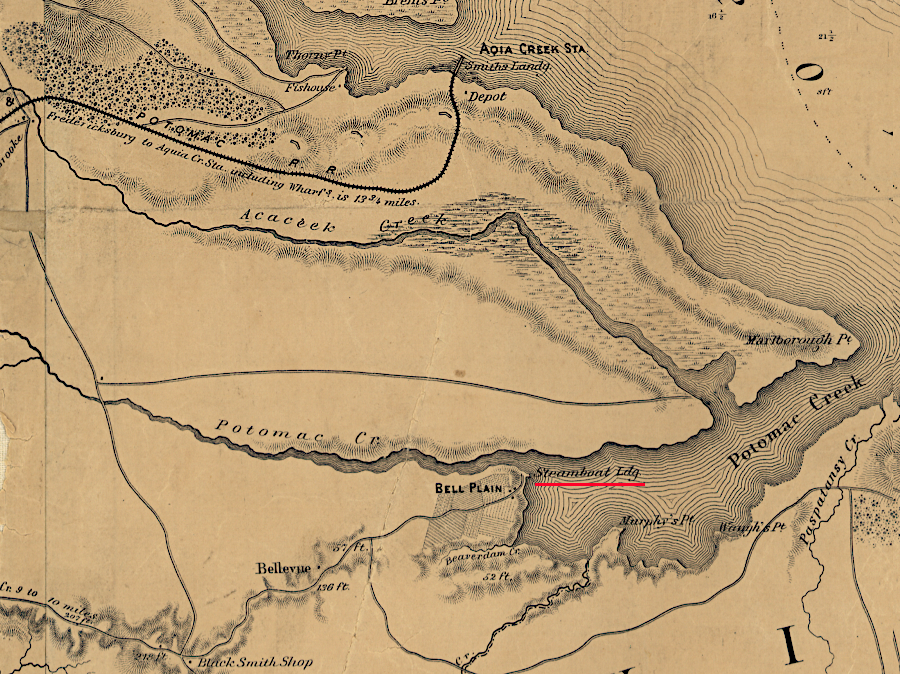
the Richmond, Fredericksburg, and Potomac (RF&P) Railroad ended at Aquia Landing until 1872
Source: Library of Congress, Map of n. eastern Virginia and vicinity of Washington ("McDowell Map," 1862)
During the first year of the Civil War, Confederates blockaded the Potomac River by placing cannon at several bluffs on the Prince William County shoreline. In contrast to the War of 1812, when British ships had to wait five days before getting a favorable wind in order to sail past the American battery at Belvoir, steam power allowed Union ships to move independently from weather conditions. However, the batteries were so high on the bluff that the Union boats could not effectively aim their guns at the Confederates.
The US Navy never mounted an effective attack on the Potomac River batteries. It regained control of the Potomac River only after Confederates withdrew in March, 1862 when the Peninsula Campaign threatened Richmond.
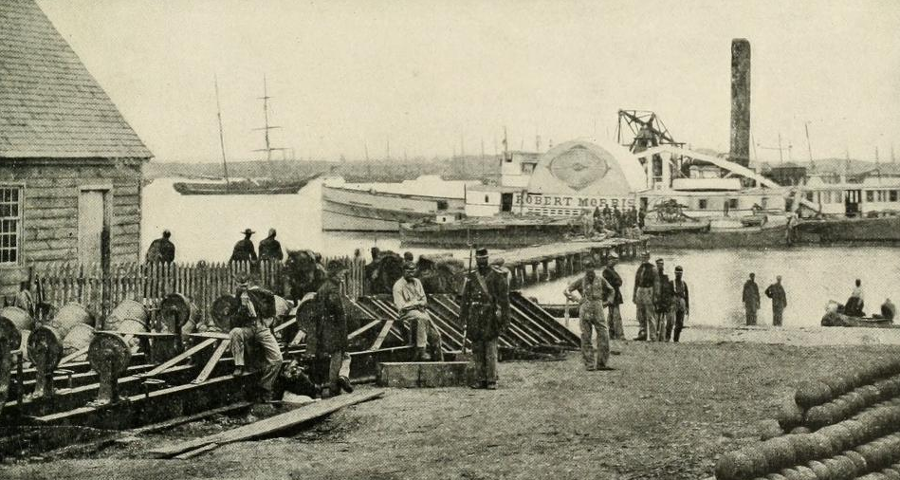
General McClellan changed his base during the Peninsula Campaign, and steamships that had carried supplies to White House on the Pamunkey River switched to Berkeley Plantation (Harrison's Landing)
Source: The Photographic History of the Civil War, Loading the Transports (p.272)
Starting in March 1862, the Union Navy dominated travel on almost all Tidewater Virginia rivers and Chesapeake Bay. However, the Union Navy could not block smuggling trips in small boats across the Potomac River; they continued throughout the war.
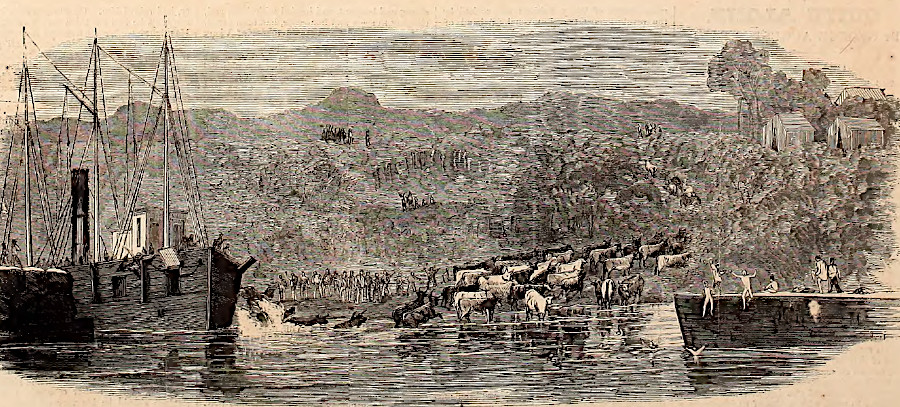
Union steamboats brought supplies to soldiers throughout the Civil War, while Confederates relied upon just wagons and railroads
Source: Harper's Weekly, General Grant's Campaign - Landing of Cattle for the Use of the Army (July 9, 1864, p.437)
The Elizabeth River was the next to last to come under Union control. The James River remained under Confederate control upstream of Fort Darling on Drewry's Bluff until the end of the Civil War; Confederates retained controlled that stretch and blocked Union warships from steaming up the James River to Richmond. The Union Navy reached Richmond only after Fort Darling was abandoned, following the fall of Petersburg in April 1865.
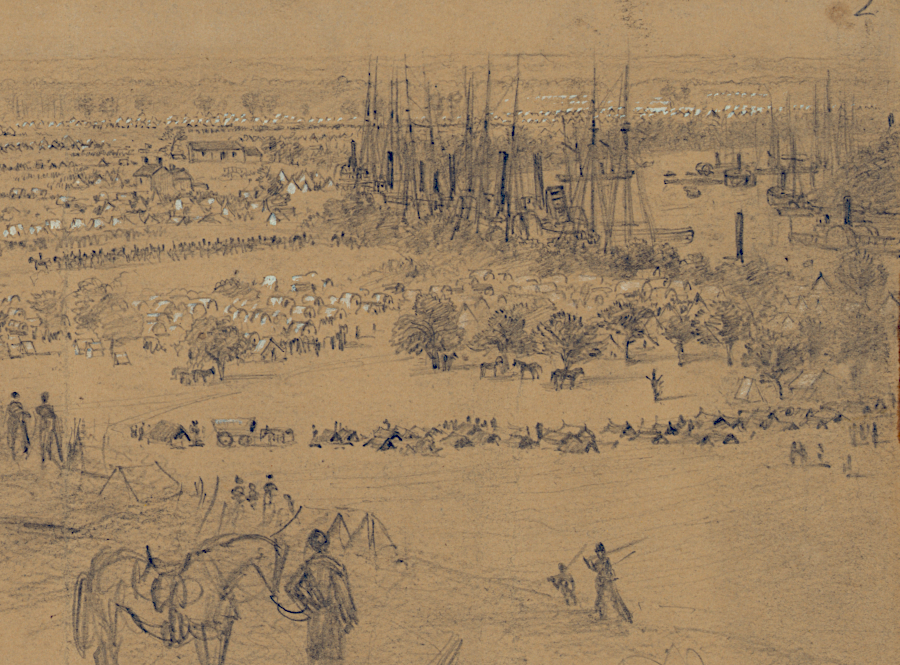
steamships brought supplies and troops up the York, and later the James River, for the Peninsula Campaign
Source: Library of Congress, Camp at Cumberland with a view of the Pamunkey River full of gunboats and transports (by Alfred R. Waud, 1862)
When the Peninsula Campaign led to a concentration of forces at Fort Monroe in March 1862, the CSS Virginia ironclad sailed out of the Elizabeth River and easily defeated several wooden warships in Hampton Roads. The timely arrival of the USS Monitor led to the first battle of ironclad, steam-powered warships. While neither ironclad could destroy the other, the Union Navy was able to keep the CSS Virginia bottled up in the Elizabeth River. Union steamboats brought bring massive amounts of supplies for the Peninsula Campaign up the York River to White House Landing.
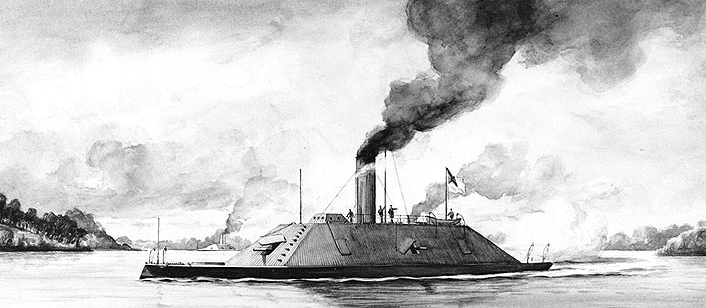
the CSS Richmond was a Confederate ironclad constructed initially at the Norfolk Navy Yard, completed in Richmond after the Confederates abandoned Hampton Roads, and trapped upstream of Drewry's Bluff for the rest of the Civil War
Source: US Navy - Naval Historical Center, CSS Richmond (1862-1865)
President Lincoln is credited with organizing the Union Army attack on Norfolk, which led to the Confederates destroying the CSS Virginia. That ship is the most famous Confederate ironclad, but others were constructed at the Norfolk Navy Yard and Richmond. The remaining coal-fired ironclads of the Confederate Navy in Virginia remained in the James River, upstream of Drewry's Bluff, throughout the war. Federal barricades in the river prevented those Confederate ironclads from threatening Union shipping until the war ended, though the James River Squadron made one major-but-unsuccessfully attempt to break out and go on the offensive in January, 1865.4
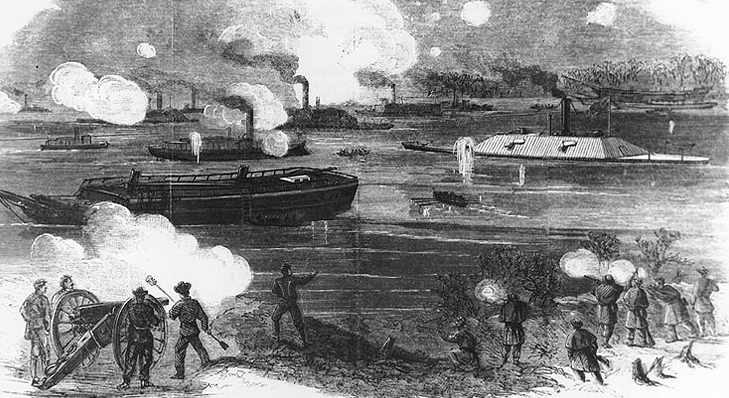
the James River Squadron of the Confederate Navy was unable to get past Federal barricades and ships after March, 1862, so the Union Navy could use Virginia waterways with impunity for most of the Civil War
Source: Harper's Weekly, "The Rebel Iron-Clad Fleet Forcing the Obstructions in James River" 23 January 1865
The Confederate Army withdrew from Northern Virginia at the start of March, 1962 as Union General George B. McClellan pressed towards Richmond in the Peninsula Campaign. The Confederates recognized that they would not be running steamboats on the Potomac River again unless the secession effort was successful, but Union forces could use Aquia Landing as a supply base. To prevent that, the withdrawing Confederates destroyed the Richmond, Fredericksburg and Potomac Railroad wharf at Aquia Landing, the track to Fredericksburg, and trestles along that route.
During the 1864 Overland Campaign, the Union Army needed to get supplies to troops south of Fredericksburg. The solution was to float barges with loaded railroad cars down the Potomac River from Alexandria, build a new railroad wharf at Belle Plain, and lay track from the new wharf to Fredericksburg.
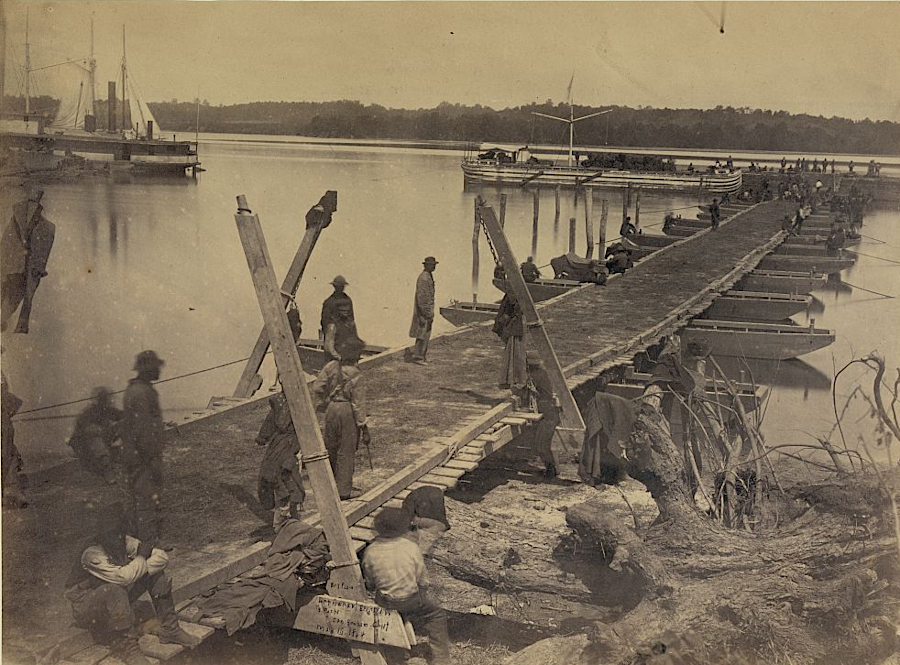
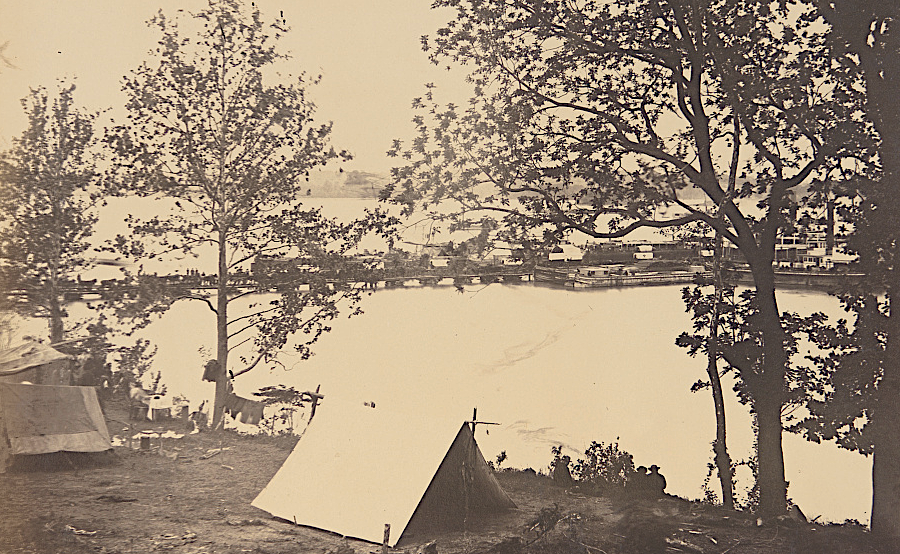
Union forces built a new steamboat landing at Belle Plain in 1864, and the US Military Railroad built track to Fredericksburg
Source: Library of Congress, Upper wharf, Belle Plain. Built by U.S.M.R.R. Construction Corps (May 16, 1864); Belle Plain, May 18, 1864
After the Civil War, the Richmond, Fredericksburg and Potomac Railroad had no legal rights to the Belle Plain site or the track leading to it from Fredericksburg. The company chose to rebuilt Aquia Creek Wharf, and the new track to that old steamboat landing opened again on September 22, 1865. However, the winter of 1867-68 was so cold that the river froze and steamboat travel was blocked by ice for 11 weeks.
To eliminate the costs and delays associated with the steamboat segment, the Richmond, Fredericksburg and Potomac Railroad built track north to Quantico and the Pennsylvania Railroad built track south. On July 18, 1872, the first train traveled directly on the new track between Fredericksburg and Alexandria Railroad. The Richmond, Fredericksburg and Potomac Railroad then sold its shares in the Potomac Steamboat Company and synchronized its schedule with trains of the Pennsylvania Railroad. The Pennsylvania Railroad was the great rival of the Baltimore and Ohio Railroad, and was engaged in cutthroat competition for control of Southern railroads that were bankrupted by the Civil War and the subsequent economic depression in former Confederate states.
A majority of stockholders in the Richmond, Fredericksburg and Potomac Railroad were allies of the Baltimore and Ohio Railroad. They objected to the alignment with the Pennsylvania Railroad. The Board of Directors fired the president of the Richmond, Fredericksburg and Potomac Railroad and renewed the relationship with the Potomac Steamboat Company; use of Aquia Landing to transfer freight and passengers continued despite the through track that had been completed in 1872.
The Pennsylvania Railroad countered by routing its Alexandria-Richmond traffic via Gordonsville rather than Quantico. It directed Alexandria-Richmond traffic via the old Orange and Alexandria Railroad to Gordonsville (by then the Virginia Midland Railway) and the old Virginia Central Railroad (by then the Chesapeake and Ohio Railroad), bypassing the Richmond, Fredericksburg and Potomac Railroad and cutting its revenue. The Pennsylvania Railroad also used its political influence to get the US Post Office to say it would cancel the lucrative contract with the Richmond, Fredericksburg and Potomac Railroad to carry the mail.
The economic pressure was successful; the Richmond, Fredericksburg and Potomac Railroad reversed course. It ended its business with the Potomac Steamboat Company and direct Fredericksburg-Alexandria train travel was restored.5
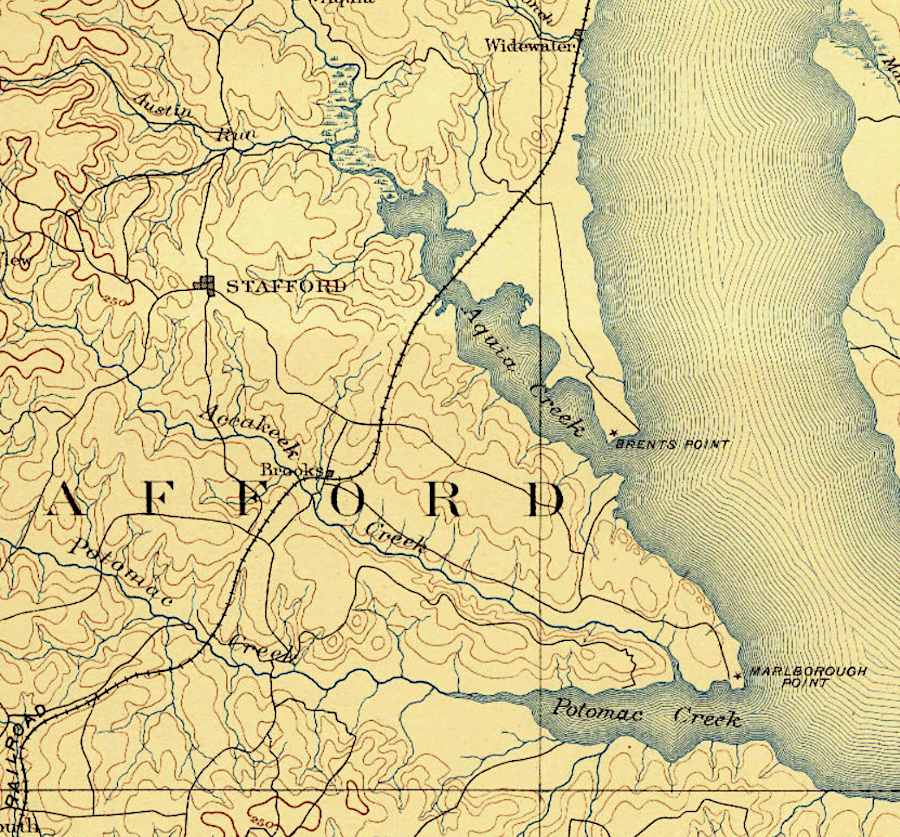
after 1872, Richmond, Fredericksburg and Potomac Railroad trains could go directly to Alexandria and Aquia Landing was eventually abandoned
Source: US Geological Survey (USGS), Fredericksburg VA 1:125,000 topographic quadrangle (1889)
After World War I passengers had the option to travel by car rather than by steamboat, and the Great Depression substantially reduced the profits of the steamboat companies. Virginia and Maryland officials objected to proposals by the companies to reduce or eliminate service, knowing that shoreline communities in the Chesapeake Bay and on major rivers would become more isolated. A hurricane on August 23, 1933 smashed the docks and wharves at landings throughout the region. It was not economically feasible to rebuild those facilities in the depths of the Great Depression.
Some steamboat operations, especially ferry service to cross the major rivers, continued until bridges and tunnels connected places in the 1950's. One steamboat resort on the Rappahannock River in Essex County lasted until 1970. The Jackson Beach resort was built originally for white customers traveling by steamers, when even recreational beaches were segregated by race. In the 1930's the resort was repurposed for black ("colored") families and renamed Mark Haven.
The Mark Haven survived the decline of steamboat travel. It advertised in the Green Book as a welcoming halfway stop for black customers driving between Washington, DC and Hampton Roads. Desegregation in the 1960's ultimately enabled those customers to stay at all hotels on the highway, and the Mark Haven resort closed in 1970.6
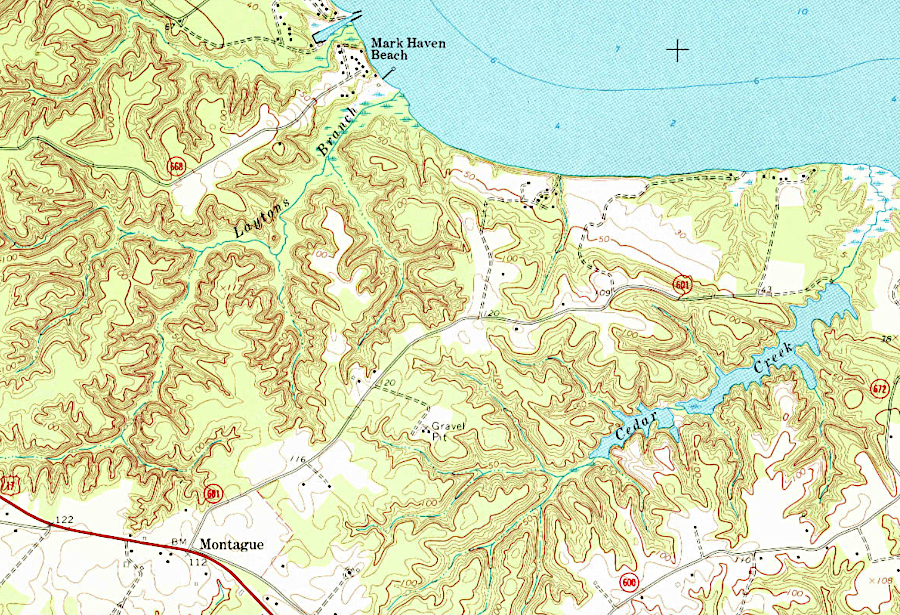
desegregation, rather than the end of steamboat traffic, caused the Mark Haven resort on the Rappahannock River to close in 1970
Source: US Geological Survey (USGS), Morattico VA 1:24,000 scale topographic quadrangle map (1968)
Links
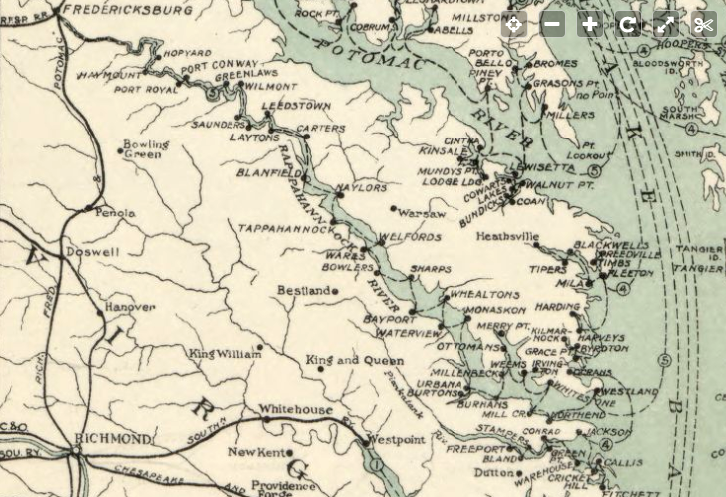
in 1926, steamships stopped at multiple wharves along the Rappahannock River
Source: Library of Congress, Transportation lines of Chesapeake Bay serving the port of Baltimore MD (US Army Corps of Engineers, 1926)
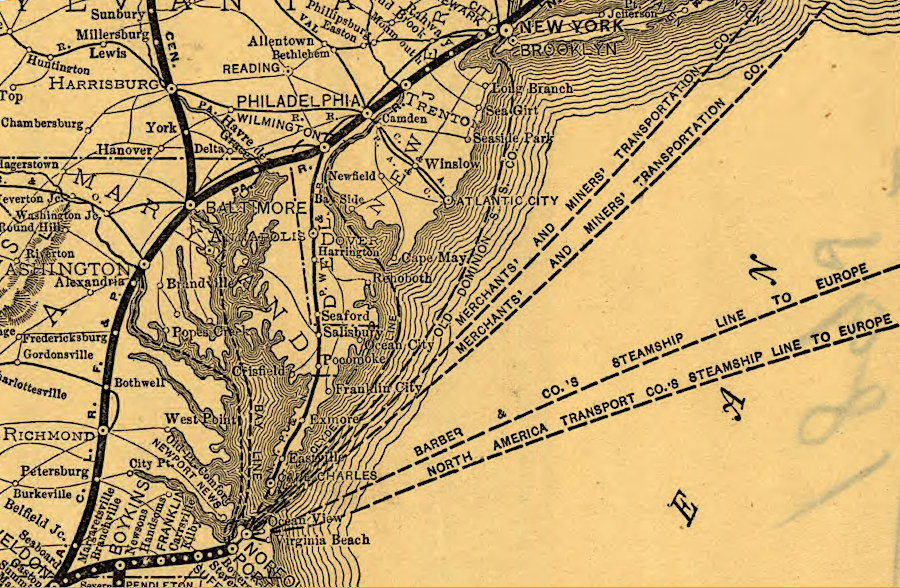
starting in the 1840's, Hampton Roads port cities were connected by steamships to northern cities and Europe
Source: Library of Congress, Map of the Seaboard Air Line and its principal connections north, south, east & west, 1896 (Rand McNally and Company)

Union steamboats transported troops via the Chesapeake Bay throughout the Civil War
Source: Frank Leslie's Illustrated History of the Civil War, The New Jersey Troops Crossing the Chesapeake Bay, in Sixteen Propellers, on Their Way to Washington, May 4, 1861 (p.182)
References
1. "Birthplace of the Steamboat," Atlas Obscura, http://www.atlasobscura.com/places/birthplace-steamboat-rumsey-memorial; "John Fitch's Steamboat Historical Marker," ExplorePAhistory.com, http://explorepahistory.com/hmarker.php?markerId=1-A-394 (last checked January 11, 2015)
2. "Transportation," in Virginia - A Guide to the Old Dominion, Works Progress Administration, University Press (New York), 1940, https://archive.org/details/in.ernet.dli.2015.152220; "Old Bay Line - President Warfield Became The Famous SS Exodus," Cruising the Past, August 23, 2009, http://cruiselinehistory.com/old-bay-line-president-warfield-became-the-famous-ss-exodus/ (last checked January 12. 2025)
3. "The Army of the Potomac.; The Flying Column. Potomac Creek and its Landings - The Selden Mansion - Discovery of a Favorable Point for a New Landing - Incidents of a Soldier's Life," New York Times, February 22, 1863, https://www.nytimes.com/1863/02/22/archives/the-army-of-the-potomac-the-flying-column-potomac-creek-and-its.html; C. Coleman McGehee, "I've been working on the railroad: the saga of the Richmond, Fredericksburg and Potomac Railroad Company," Masters Thesis, University of Richmond, 1992, p.3, p.9, https://scholarship.richmond.edu/cgi/viewcontent.cgi?article=1748&context=masters-theses; William E. Griffin Jr., One Hundred Fifty Years of History Along the Richmond, Fredericksburg and Potomac Railroad, 1984, p.2, https://www.google.com/books/edition/One_Hundred_Fifty_Years_of_History/IFSMGQAACAAJ (last checked January 12, 2025)
4. John M. Coski, "James River Squadron," Encyclopedia Virginia, Virginia Foundation for the Humanities, March 4, 2011, https://www.encyclopediavirginia.org/james_river_squadron; "Cultural Resources: Cockpit Point Battlefield Study," Prince William County Office of Historic Preservation, https://www.pwcva.gov/department/planning-office/cockpit-point-battlefield-study (last checked January 12, 2025)
5. C. Coleman McGehee, "I've been working on the railroad: the saga of the Richmond, Fredericksburg and Potomac Railroad Company," Masters Thesis, University of Richmond, 1992, pp.17-19, https://scholarship.richmond.edu/cgi/viewcontent.cgi?article=1748&context=masters-theses (last checked January 12, 2025)
6 "A big hurricane in 1933 changed a lot of things around the Chesapeake Bay," Washington Post, September 27, 2014, https://www.washingtonpost.com/local/a-big-hurricane-in-1933-changed-a-lot-of-things-around-the-chesapeake-bay/2014/09/27/71bbd6c8-44e5-11e4-9a15-137aa0153527_story.html; "Mark Haven Beach Hotel," The Architecture of the Negro Traveler's Green Book, The Institute for Advanced Technology in the Humanities, University of Virginia, https://community.village.virginia.edu/greenbooks/content/mark-haven-beach-hotel (last checked May 21, 2025)
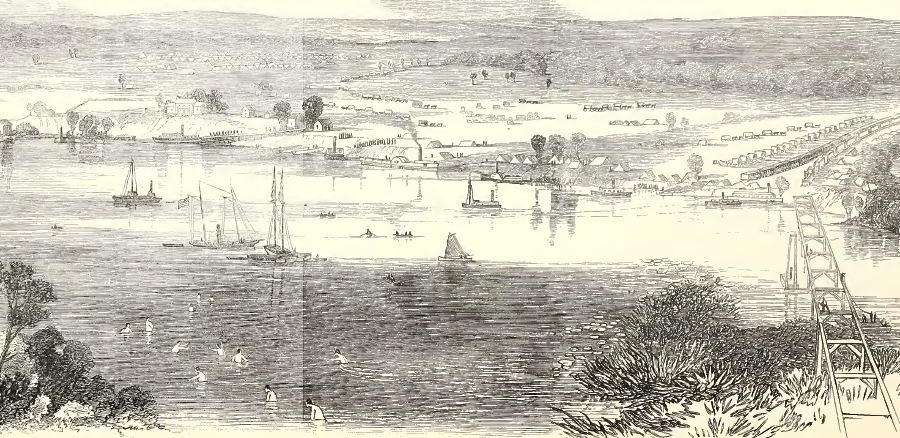
Union General McClelland planned the 1862 Peninsula Campaign to take advantage of steamboats, and assumed the Confederates had no significant naval forces that could interrupt water-based supply lines to White House Landing
Source: Frank Leslie's Illustrated History of the Civil War, White House Landing, Pamunkey River VA The Grand Depot of the Commissariat and Ordnance Department of the Army Before Richmond (p.142)
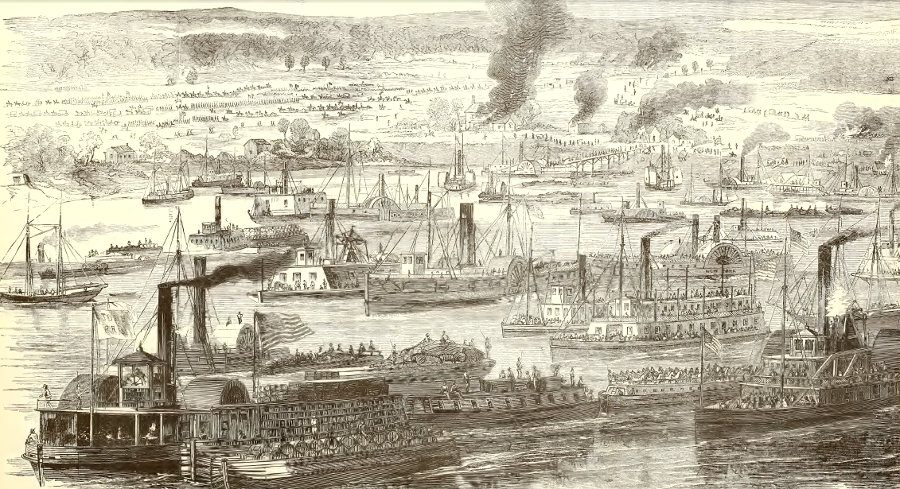
after General McClellan grew alarmed at aggressive attacks by General Lee, the Union forces abandoned White House Landing and changed their supply base to Harrison Landing (Berkeley Plantation) on the James River
Source: Frank Leslie's Illustrated History of the Civil War, Burning of the White House - The Federal Troops By Command of General McClellan Abandoning Their Position at the White House and Breaking Up the Commissariat Depot on the Pamunkey River - Departure of the Union Flotilla For the James River June 26th 1862 (p.192)
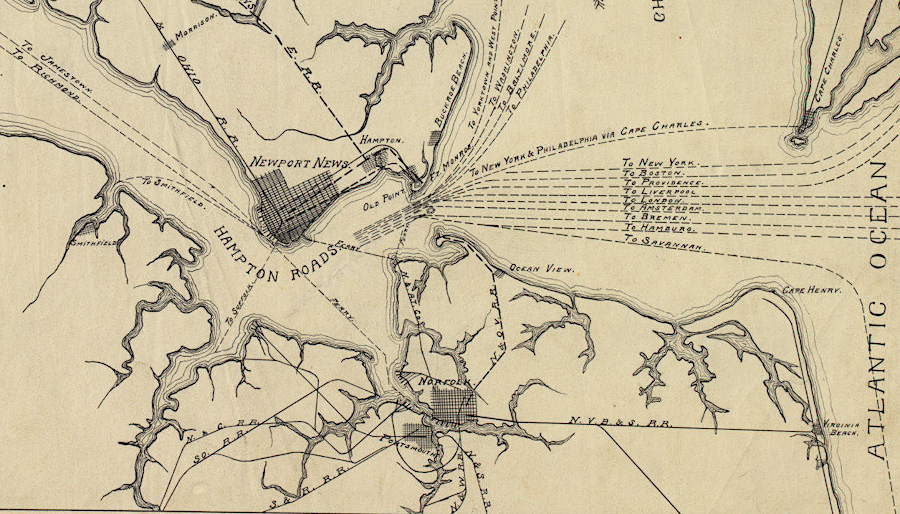
when Jamestown commemorated its 300th anniversary in 1907, there was scheduled steamship service from Hampton Roads to London, Liverpool, Amsterdam, Hamburg, Bremen, as well as North American ports
Source: Newport News Public Library, Jamestown Ter-Centennial Map
From Feet to Space: Transportation in Virginia
Virginia Places



















